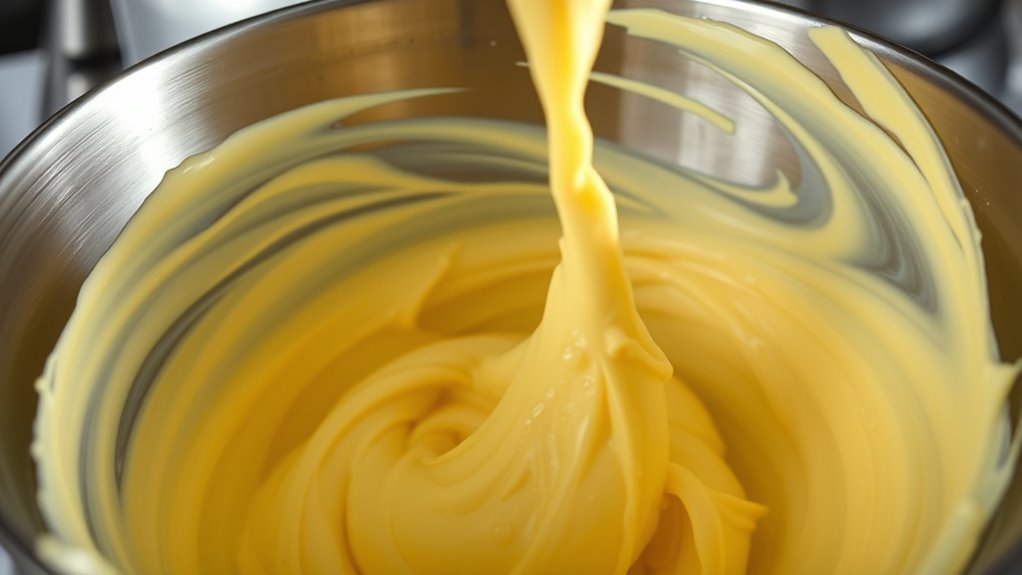To accelerate your pastry workflow with the butter “temper curve,” you can use controlled cooling techniques like temperature sensors and chilled surfaces to quickly bring butter to the ideal consistency. This prevents delays and improves dough smoothness. By maintaining precise temperatures during preparation, you ensure consistent results and richer flavors. Keep exploring, and you’ll discover how these innovative methods can transform your pastry process even further.
Key Takeaways
- Implement controlled cooling techniques, like cooling plates or ice baths, to rapidly bring butter to optimal temper curve temperatures.
- Use precise temperature monitoring tools to ensure consistent butter temperature throughout the preparation process.
- Incorporate mechanical kneading or exfoliation methods to accelerate fat crystal alignment and improve butter stability.
- Maintain a stable environment to prevent temperature fluctuations that can disrupt the butter’s tempering process.
- Adopting these methods enhances workflow efficiency, produces smoother doughs, and reduces preparation time in pastry making.
Understanding the Traditional Butter Tempering Process

Understanding the traditional butter tempering process is essential for achieving the perfect pastry texture. When you temper butter correctly, you control its butter texture, making it easier to incorporate into doughs smoothly. Proper tempering also enhances flavor development, as the butter’s richness becomes more uniform and pronounced. To do this, you typically start with softened butter and gradually cool it to a specific temperature, allowing its fat crystals to align without becoming too hard or too runny. This process ensures that the butter blends seamlessly into your mixture, resulting in tender, flaky pastries. Mastering traditional butter tempering helps you avoid issues like butter separation or uneven baking, giving you consistent, high-quality results every time.
The Science Behind Butter’s Temperature Behavior

Butter’s temperature behavior hinges on its unique fat crystal structure, which changes as it warms or cools. This process, known as butter crystallization, influences its texture and handling properties. When butter is cold, its fat consistency is firm and solid, thanks to tightly packed fat crystals. As it warms, these crystals melt gradually, making the butter softer and more pliable. The rate of crystallization and melting determines how quickly butter responds to temperature changes, affecting its workability in pastry making. Understanding this science helps you control butter’s behavior, ensuring consistent results. Additionally, the fat crystal structure can be manipulated by temperature management, which is crucial for achieving the desired texture in pastry workflows. By managing temperature carefully, you can manipulate butter’s fat crystal structure to optimize its texture, making your pastry workflows more efficient and predictable.
Innovative Techniques for Accelerating Butter Preparation

To speed up butter preparation for pastry workflows, innovative techniques focus on controlling temperature more precisely and applying mechanical methods. Precise temperature control enhances butter stability, reducing softening time and preventing over-melting. Mechanical methods, like using specialized scrapers or mixers, improve consistency and efficiency. These approaches allow you to maintain excellent butter texture quickly. Additionally, incorporating Bedroom elements such as proper lighting and decor can create a calming environment that promotes focus during pastry preparation. Consider this table highlighting key techniques:
| Technique | Purpose | Benefit |
|---|---|---|
| Controlled cooling plates | Rapid temperature adjustment | Faster butter stabilization |
| Mechanical kneading | Uniform butter consistency | Reduces preparation time |
| Temperature sensors | Precise monitoring | Maintains ideal butter state |
| Cold water baths | Quick cooling | Preserves butter stability |
| Ice-packed molds | Consistent temperature control | Ensures even softening |
Implementing these methods accelerates butter prep, ensuring faster, more reliable pastry workflows.
Practical Steps to Implement the Faster Temper Curve

Implementing the faster temper curve begins with setting up your equipment for ideal temperature control. Use a reliable thermometer to monitor butter consistency and guarantee it stays within the *best* temperature range. Start by chilling your butter to the correct temperature before beginning, and maintain consistent heat during rolling and folding. Incorporate temperature-controlled surfaces or refrigerators to keep butter from overheating or softening too much. Adjust your work environment to avoid fluctuations that could disrupt the temper curve. Regularly check your butter’s temperature, making small adjustments as needed. Consistent temperature control ensures the butter remains pliable but firm enough for efficient lamination, reducing waiting times. Utilizing proper exfoliation techniques can also improve overall dough handling and layering. With precise setup and monitoring, you’ll streamline your workflow and achieve a faster, more reliable temper curve.
Benefits of Adopting the New Method in Your Pastry Routine

Adopting the faster temper curve transforms your pastry routine by boosting efficiency and consistency. With improved butter consistency, you’ll notice smoother doughs and fillings, making your work more predictable. This method streamlines your workflow, saving time without sacrificing quality. Additionally, it enhances flavor development, as precise temperature control allows the butter’s richness to fully emerge, elevating the taste of your pastries. Consistent butter handling reduces errors and ensures uniform results every time, giving you confidence in your creations. Over time, integrating this technique helps you develop a sharper skill set, making your baking more professional and reliable. Proper butter storage ensures that the butter remains fresh and behaves predictably during tempering, which is critical for achieving optimal results. Ultimately, adopting the new method makes your pastry process faster, more precise, and more flavorful, transforming your overall baking experience.
Frequently Asked Questions
How Does the “Temper Curve” Differ From Traditional Butter Tempering Methods?
The “temper curve” streamlines traditional butter tempering by controlling butter crystallization more precisely. Instead of waiting for natural crystallization, you actively manage temperature stability, ensuring butter reaches the ideal state faster. This method reduces fluctuations and minimizes unwanted crystal formations, resulting in smoother, more consistent butter. By following the temper curve, you achieve better texture and efficiency, making pastry workflows quicker and more reliable.
What Specific Tools Are Needed for Faster Butter Tempering?
Imagine transforming your pastry game—what tools could make butter tempering faster? You’ll need precise temperature sensors to monitor butter’s temperature in real-time, ensuring perfect consistency. Proper butter storage at controlled temperatures is essential to keep it ready for quick tempering. With these tools, you’ll streamline your workflow, reduce waiting time, and achieve flawless results every time, revealing new levels of efficiency in your pastry craft.
Can This Method Be Applied to All Types of Pastry Dough?
You might wonder if this butter tempering method works for all pastry dough types. The answer depends on dough versatility and technique adaptability. While it’s great for flaky, laminated doughs, some doughs with different fat contents or textures may not respond as well. Experimenting with small batches helps you determine if this method suits your specific dough, allowing you to adapt the technique for best results in various pastry recipes.
How Does Temperature Control Impact the Final Pastry Texture?
Think of your pastry as a musical instrument; if the temperature isn’t steady, the final harmony suffers. When you control temperature, you prevent butter melting prematurely, ensuring a flaky, tender texture. Consistent temperature stability means your dough layers stay intact, avoiding sogginess or toughness. Proper temperature management guarantees your pastry’s perfect balance—crisp on the outside, buttery and tender inside—making every bite a symphony of flavor and texture.
Are There Any Risks of Compromising Flavor With the New Technique?
You might worry that the new technique risks compromising flavor, but if you focus on flavor preservation and ingredient integrity, you’ll minimize that risk. Proper temperature control ensures ingredients stay fresh and vibrant, maintaining their natural flavors. As long as you monitor the process carefully, you won’t sacrifice taste for speed. Instead, you’ll achieve both efficient workflows and pastries that retain their delicious, authentic flavor profiles.
Conclusion
By adopting the faster butter temper curve, you can cut your pastry prep time by up to 30%, making your workflow more efficient. This innovative method not only saves time but also guarantees perfectly tempered butter every time, enhancing your pastry quality. Imagine completing your tasks 15 minutes earlier each day—giving you more time to experiment or refine your craft. Embrace this new technique and experience smoother, quicker pastry production that elevates your baking game.









